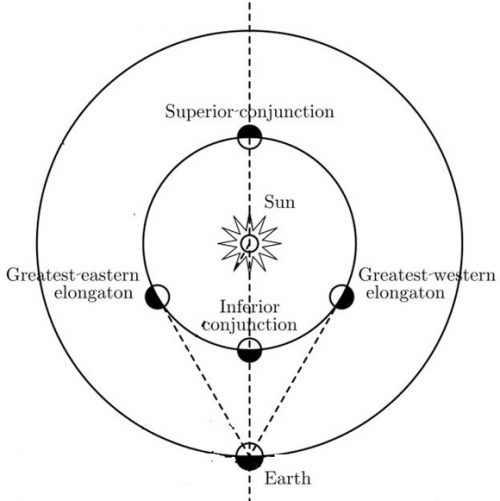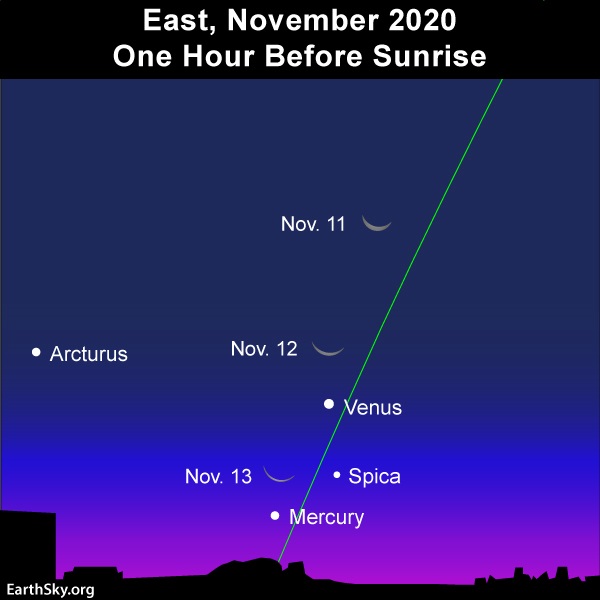Click here to find about the Taurid meteor shower
For northerly latitudes, this upcoming week presents a golden opportunity to spot elusive Mercury in the morning sky. Here’s how to find Mercury from around the world. On November 10 and 11, 2020, look for the waning crescent moon and the dazzling planet Venus. These two brilliant beauties should be easy to see in the east before sunrise. An imaginary line from the moon through Venus will point in the general direction of Mercury on November 10 and 11. Look for Mercury near the horizon as predawn darkness begins to give way to morning twilight.
If you can’t see Mercury with the unaided eye, try your luck with binoculars.
Mercury is quite bright right now, some 4 times brighter than a 1st-magnitude star.
In fact, there will be a 1st-magnitude star near Mercury on the sky’s dome: Spica, the brightest star in the constellation Virgo the Maiden. Try not to mistake Spica for Mercury or vice versa! Mercury will probably appear as the brighter of the two. Also, look for another 1st-magnitude star, orange Arcturus, also near Mercury and Venus before sunup.
Mercury officially resides in the morning sky throughout November 2020. But it’s on November 10 that Mercury reaches its greatest elongation from the sun. Although Mercury’s elongation is the same worldwide (19 degrees west of the sun, appearing in the east before sunrise), the span of time between Mercury-rise and sunrise is greater at more northerly latitudes and less at more southerly latitudes.
That why this November 2020 morning apparition of Mercury favors the Northern Hemisphere. Mercury will continue to brighten as this world rises better than 1 1/2 hours (90 minutes) before the sun (at mid-northern latitudes).

At mid-northern latitudes, Mercury actually rises a short while before astronomical twilight (dawn’s first light). That’s unusual; usually we see it in twilight. Want to know when astronomical twilight comes into your morning sky? Click on Old Farmer’s Almanac (U.S. and Canada). Or try Sunset Sunset Calendars (for all places worldwide), remembering to check the astronomical twilight box.
We give the approximate rising time for Mercury at various latitudes for the next several mornings (given a level horizon):
60 degrees north latitude
Mercury rises 2 1/2 hours (150 minutes) before the sun40 degrees north latitude
Mercury rises 1 2/3 hours (100 minutes) before the sunEquator (0 degrees latitude)
Mercury rises 1 1/10 hours (70 minutes) before the sun35 degrees south latitude
Mercury rises 3/4 hour (45 minutes) before the sunWant more specific information? Try Old Farmer’s Almanac (U.S. and Canada) or TimeandDate (other places worldwide).
No matter where you live worldwide, it’s best to find an unobstructed horizon in the direction of sunrise for your Mercury quest. Find a hill or balcony, so that you can peek just a little farther over the horizon. That little extra could make the difference in sighting – or not sighting – Mercury, especially at southerly latitudes. Binoculars help out too!

Bottom line: Mercury is one of our sky’s bright planets, but it’s often lost in the sun’s glare. As the innermost planet of our solar system, Mercury appears from Earth to be closely tethered to the sun in our sky. Often it’s behind, or in front of, the sun from our earthly vantage point. Even when it swings farthest from the sun on our sky’s dome – in the west after sunset or east before sunrise – Mercury often has to compete with the twilight and so isn’t always easy to see. But this coming week is an excellent time to look for Mercury, if you live in Earth’s Northern Hemisphere.











